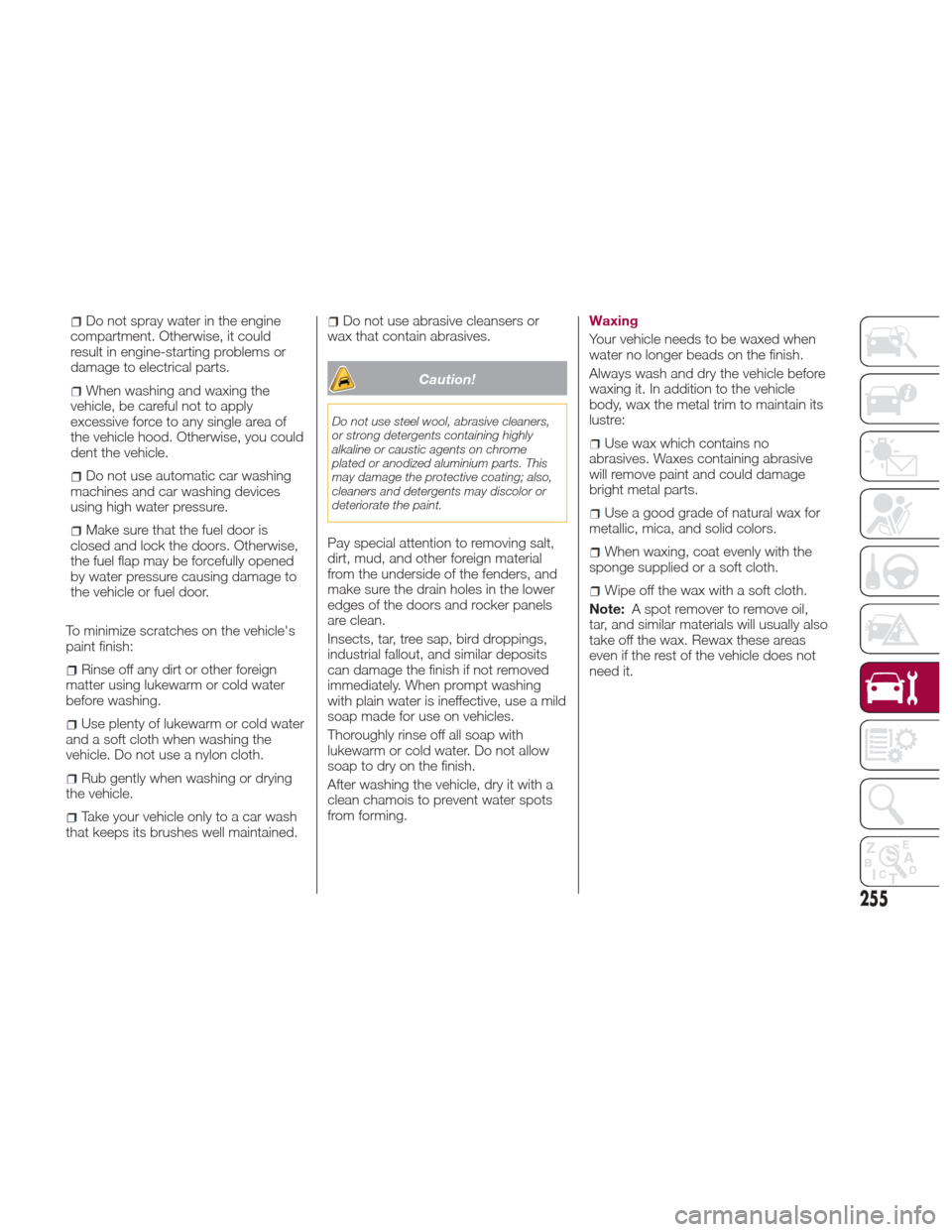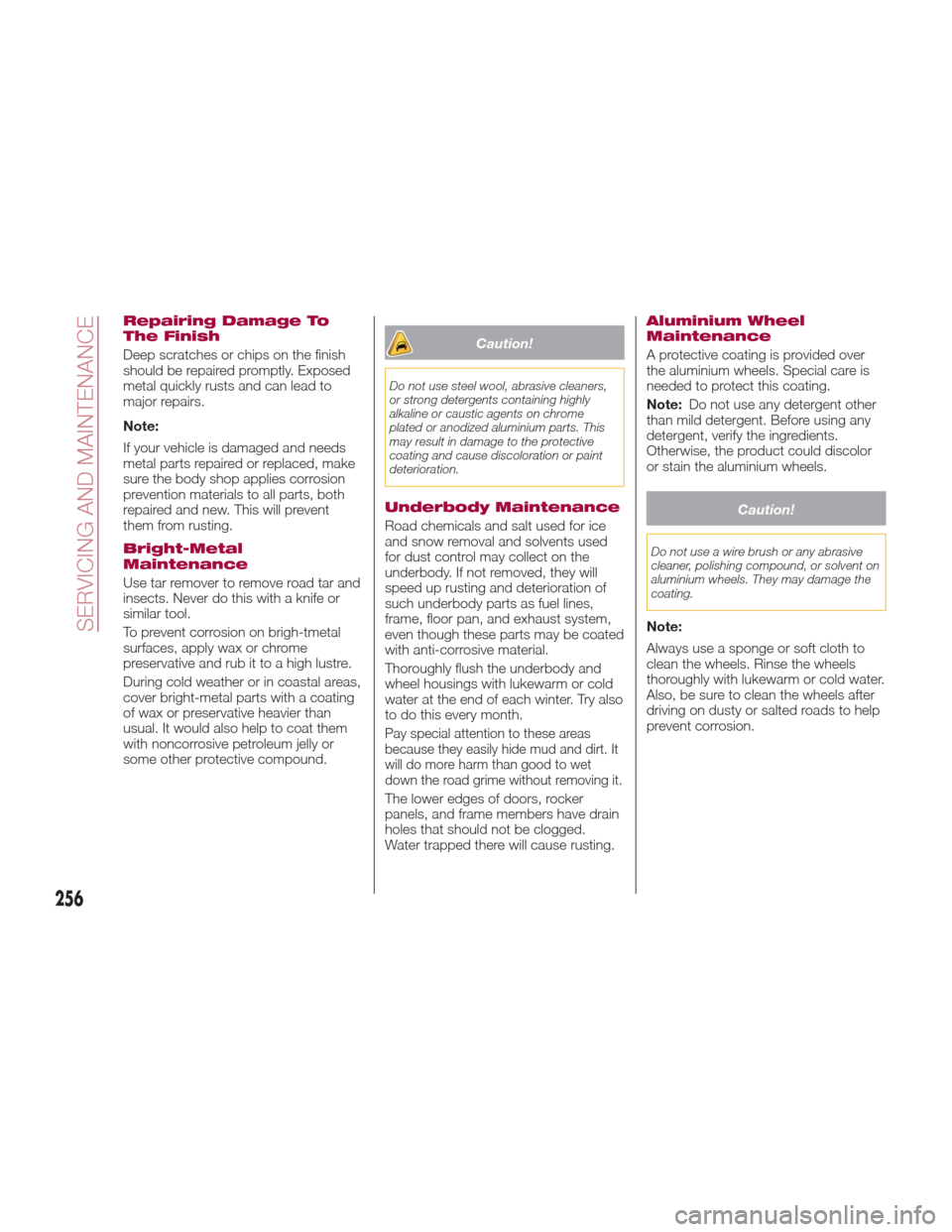2017 FIAT 124 SPIDER ABARTH Fuel drain
[x] Cancel search: Fuel drainPage 4 of 292

Read This Carefully
REFUELING
Only refuel with unleaded gasoline with a rating 91 octane recommended not less than 87 octane acceptable. Do not use gasoline containing
methanol or ethanol E85. Using these mixtures may cause misfiring and handling issues, as well as damage fundamental components of the
fuel supply system.
STARTING THE ENGINE
If Equipped with a manual transmission: Be sure that the parking brake is engaged; place the gear selector to NEUTRAL, fully depress the
clutch pedal without pressing the accelerator, then push the ignition button, the engine starts as soon as the ignition is pushed.If Equipped with a automatic transmission : Be sure that the parking brake is engaged and that the gear selector is in PARK (P) or
NEUTRAL (N) , depress the brake pedal, then push the ignition button, the engine starts as soon as the ignition is pushed.
PARKING ON FLAMMABLE MATERIAL
The catalytic converter develops high temperatures during operation. Do not park the vehicle on grass, dry leaves, pine needles or other
flammable material: fire hazard.
RESPECTING THE ENVIRONMENT
The vehicle is equipped with a system that carries out a continuous diagnosis of the emission-related components in order to help protect the
environment.
ELECTRICAL ACCESSORIES
Contact your Authorized Dealer if you decide to add electrical accessories (with the risk of gradually draining the battery) after buying the
vehicle. They can calculate the overall electrical requirement and check that the vehicle's electric system can support the required load.
SCHEDULED SERVICING
Correct maintenance of the vehicle is essential for ensuring that it maintains its performance and its safety features, its environmental
friendliness and low running costs are unchanged over time.
Page 257 of 292

Do not spray water in the engine
compartment. Otherwise, it could
result in engine-starting problems or
damage to electrical parts.
When washing and waxing the
vehicle, be careful not to apply
excessive force to any single area of
the vehicle hood. Otherwise, you could
dent the vehicle.
Do not use automatic car washing
machines and car washing devices
using high water pressure.
Make sure that the fuel door is
closed and lock the doors. Otherwise,
the fuel flap may be forcefully opened
by water pressure causing damage to
the vehicle or fuel door.
To minimize scratches on the vehicle's
paint finish:
Rinse off any dirt or other foreign
matter using lukewarm or cold water
before washing.
Use plenty of lukewarm or cold water
and a soft cloth when washing the
vehicle. Do not use a nylon cloth.
Rub gently when washing or drying
the vehicle.
Take your vehicle only to a car wash
that keeps its brushes well maintained.
Do not use abrasive cleansers or
wax that contain abrasives.
Caution!
Do not use steel wool, abrasive cleaners,
or strong detergents containing highly
alkaline or caustic agents on chrome
plated or anodized aluminium parts. This
may damage the protective coating; also,
cleaners and detergents may discolor or
deteriorate the paint.
Pay special attention to removing salt,
dirt, mud, and other foreign material
from the underside of the fenders, and
make sure the drain holes in the lower
edges of the doors and rocker panels
are clean.
Insects, tar, tree sap, bird droppings,
industrial fallout, and similar deposits
can damage the finish if not removed
immediately. When prompt washing
with plain water is ineffective, use a mild
soap made for use on vehicles.
Thoroughly rinse off all soap with
lukewarm or cold water. Do not allow
soap to dry on the finish.
After washing the vehicle, dry it with a
clean chamois to prevent water spots
from forming. Waxing
Your vehicle needs to be waxed when
water no longer beads on the finish.
Always wash and dry the vehicle before
waxing it. In addition to the vehicle
body, wax the metal trim to maintain its
lustre:
Use wax which contains no
abrasives. Waxes containing abrasive
will remove paint and could damage
bright metal parts.
Use a good grade of natural wax for
metallic, mica, and solid colors.
When waxing, coat evenly with the
sponge supplied or a soft cloth.
Wipe off the wax with a soft cloth.
Note: A spot remover to remove oil,
tar, and similar materials will usually also
take off the wax. Rewax these areas
even if the rest of the vehicle does not
need it.
255
Page 258 of 292

Repairing Damage To
The Finish
Deep scratches or chips on the finish
should be repaired promptly. Exposed
metal quickly rusts and can lead to
major repairs.
Note:
If your vehicle is damaged and needs
metal parts repaired or replaced, make
sure the body shop applies corrosion
prevention materials to all parts, both
repaired and new. This will prevent
them from rusting.
Bright-Metal
Maintenance
Use tar remover to remove road tar and
insects. Never do this with a knife or
similar tool.
To prevent corrosion on brigh-tmetal
surfaces, apply wax or chrome
preservative and rub it to a high lustre.
During cold weather or in coastal areas,
cover bright-metal parts with a coating
of wax or preservative heavier than
usual. It would also help to coat them
with noncorrosive petroleum jelly or
some other protective compound.
Caution!
Do not use steel wool, abrasive cleaners,
or strong detergents containing highly
alkaline or caustic agents on chrome
plated or anodized aluminium parts. This
may result in damage to the protective
coating and cause discoloration or paint
deterioration.
Underbody Maintenance
Road chemicals and salt used for ice
and snow removal and solvents used
for dust control may collect on the
underbody. If not removed, they will
speed up rusting and deterioration of
such underbody parts as fuel lines,
frame, floor pan, and exhaust system,
even though these parts may be coated
with anti-corrosive material.
Thoroughly flush the underbody and
wheel housings with lukewarm or cold
water at the end of each winter. Try also
to do this every month.
Pay special attention to these areas
because they easily hide mud and dirt. It
will do more harm than good to wet
down the road grime without removing it.
The lower edges of doors, rocker
panels, and frame members have drain
holes that should not be clogged.
Water trapped there will cause rusting.
Aluminium Wheel
Maintenance
A protective coating is provided over
the aluminium wheels. Special care is
needed to protect this coating.
Note:Do not use any detergent other
than mild detergent. Before using any
detergent, verify the ingredients.
Otherwise, the product could discolor
or stain the aluminium wheels.
Caution!
Do not use a wire brush or any abrasive
cleaner, polishing compound, or solvent on
aluminium wheels. They may damage the
coating.
Note:
Always use a sponge or soft cloth to
clean the wheels. Rinse the wheels
thoroughly with lukewarm or cold water.
Also, be sure to clean the wheels after
driving on dusty or salted roads to help
prevent corrosion.
256
SERVICING AND MAINTENANCE